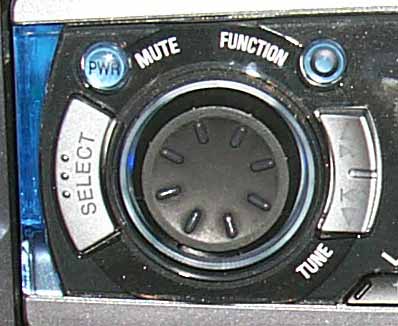Aiwa CDC-MP3 Car MP3-CD Player
by Mike Andrawes on September 25, 2000 5:51 AM EST- Posted in
- Smartphones
- Mobile
Sitting to the right of the display is the receiver for the IR transmitter of the steering wheel remote. Unfortunately, this isn't exactly the ideal location for the left hand drive cars found in the US since it simply moves the receiver that much further from the transmitter. Indeed the CDC-MP3 could use some help in this area, as our steering wheel remote was only functional when the wheel was turned such that the remote was as far right as possible. These findings have been confirmed by numerous CDC-MP3 owners posting around the internet.

Otherwise, the steering wheel remote has quite a bit potential, especially compared to the regular wireless remotes we're used to seeing with most head units. The one Aiwa has included allows for changing volume, disc, preset, and source from the remote.

The mute button is located to the left and above the volume knob, but unfortunately the system does not completely mute when you hit this button. That mute button also doubles as the power button, requiring you to hold it down for about 4 seconds to shut everything off. A simple solution to both these problems would be a dedicated power button as well as the addition of a pause button.
A function button is located to the right and above the volume knob. It should probably be named a source button because that's what it does - switch between sources. Unfortunately, there is no direct access to a specific source, so you potentially have to cycle through 3 FM, 2 AM, and 1 Auxiliary In to get to your MP3-CD if you're listening to something else.

The select button sits to the left of the rotary encoder knob and serves to cycle through audio settings, such as bass, treble, balance, fader, etc. This is also where you can access some of the more unique features that Aiwa offers, such as DSSA and H-Bass. DSSA stands for "Driver Sound Stage Adjustment." As the name suggest, it's designed to adjust the sound stage to fit a particular seat in the car. In our testing, it simply seemed to lower the volume, especially of mid to upper frequencies and flat out sounded bad. H-Bass is Aiwa's bass boost feature. The manual doesn't list a particular frequency that it works on, but there are 3 levels of boost and it seems to offer more flexibility than the loudness function included on many other units.
To the right of the rotary encoder are the track up/down buttons that also double as tuning buttons. Unfortunately, the tune buttons must be held down for about 2 seconds in order to get the unit to seek the next strong station. Ideally, this should be something that can be switched to fit the user's preference.
Like far too many manufacturers, Aiwa did not provide a way to randomize between all discs in the CD changer, only within the current disc. Further, when random mode is enabled, the fast forward/rewind capabilities of the unit are disabled and those buttons instead skip to the next song or back to the beginning of the current song, respectively. Notice that there was no skip to the previous song - it's not possible in random mode for some reason. Unfortunately, this lack of foresight with the CD-changers random mode will come back to haunt Aiwa later.
A nice touch by Aiwa is the inclusion of a source-level adjustment, which lets you adjust the relative level of the different sources that the Aiwa can access. This prevents you from destroying your ears when you radio, which may be relatively quiet, to a CD that may be much louder. We didn't find the need to use this feature, but it could come in quite handy under the right circumstances.










0 Comments
View All Comments